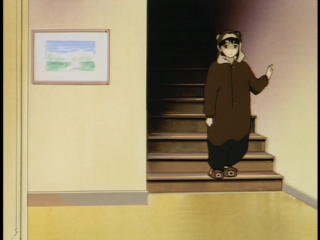Blogroll Call
Everyone loves to be on a bunch of blogrolls, but just because you’re there doesn’t mean you’ll get a lot of visitors. This becomes more true as the blogroll gets larger. Blogrolls are subject to an inverse network effect; the more blogs in the blogroll, the less valuable the link. Kaedrin gets a small amount of traffic, so even though I have a short blogroll, I’m guessing most of those blogs don’t get a ton of visitors coming from here. So I just figured I’d throw some additional links their way:
- Transit of Mercury, Photoblogged: Jay Manifold takes some nice pics of the planet Mercury, as well as an amusing comparison of Manifold Observatory and Powell Observatory.
- Team of Rivals: Andrew Olmsted reviews a recent book that chronicles Abraham Lincoln’s rise to the presidency, as well as the coalition he formed and maintained to fight the civil war:
Lincoln’s ability to hold together a coalition of abolitionists, conservative Republicans, and war Democrats during the American Civil War stands as a signal feat of political dexterity that seems yet more impressive in light of more recent American history. … the book really hits its stride once Lincoln is elected and he assembles his Cabinet, beginning with his three rivals for the nomination. The contrast is particularly stark with modern politics, where Cabinets are formed from the victor’s circle of political allies. Lincoln, on the other hand, selected men who not only wanted the job he held, but who viewed him poorly at best in some cases. It’s hard to imagine a modern politician selecting men who viewed him with the kind of contempt Edwin Stanton viewed Lincoln, let alone getting the kind of results Lincoln did. Lincoln’s ability to get results from such disparate men is an impressive primer in leadership.
Interesting stuff, and I think I’ll pick up the book at some point, as this seems to be an impressive example of compromise and tradeoffs (subjects that interest me) in action.
- Ars Technica 2006 holiday gift guide: Make shopping for the geek in your family a little easier with this guide (sheesh, that sounded like advertising copy *shudders*). Most of the hardware and gadget gifts are pretty good, though expensive. However, they also include lots of interesting books and smaller gifts as well. Ars always has interesting articles though. I’ve already mentioned the Ars System Guide on the blog recently, but they also have reviews of the Wii and PS3 that are worth reading.
- Casino Royale: Subtitle: Die almost never � nearly forever! Heh. Alexander Doenau’s take on the latest Bond flick is roughly in line with my own feelings, though one of these days I’ll get around to talking more about it on the blog.
Which may beg the question of some audiences: where is the fun when there�s nary an insane scheme to be seen, and no psychedelically decorated gyrocopters? (thank you, Roald Dahl). The answer lies partly in Bond himself. Without the scary misogyny that Ian Fleming endowed Bond with 50 years ago, Daniel Craig plays Bond as an excellent bastard. This is a Bond so confident in his own skills that he doesn�t give a care who sees him because he has a licence to kill. This is probably the only Craig film we�ll see in which Bond is able to cut as loose as he did in Uganda, because part of the story involves developing a marginally more sensible and responsible MI6 agent, but he takes the sorts of risks that make the movie fun without being stupidly unbelievable.
I love the description of James Bond as an “excellent bastard.”
- Steven Den Beste has an interesting rating system (another subject I’ll tackle on the blog at some point). He uses a 4 star scale, but also includes a “thumbs up” or “thumbs down” graphic (for obvious reasons). This is interesting because it allows him to recognize a technical accomplishment without actually recommending the film (for instance, I would give Grave of the Fireflies **** with a thumbs down because it is masterfully produced, but so heartbreaking that I can’t actually recommend it). In any case, if you scroll down on the link above (no permalinks there), you’ll see that Steven has started rating individual anime episodes for a series called Kamichu. For episode 6, he rated it zero stars with six thumbs down. I wonder if he liked it?
- A collection of Jonathan Swift’s journalistic texts: Ralf Goergens over at Chicago Boyz makes an Jonathan Swift-related annotation to Neal Stephenson’s Baroque Cycle:
Attentive readers of Neal Stephenson’s Baroque Cycle will remember Daniel Waterhouse reading a a number of astonishingly vile newspapers. Some of the most acrimonious articles were from Jonathan Swift, writing for Tory papers. Stephenson didn’t make that part up, the articles can be found here.
I didn’t have time to do more than a bit of browsing, but some of the historical characters from the Baroque Cycle are mentioned, like Marlborough, Bolingbroke, Harley and of course Queen Anne. There also are extensive footnotes explaining the concrete circumstances under which the articles appeared.
- Weblog Awards: Kevin Murphy notes that since he was inexplicably passed over for the Weblog Awards, he might as well add a bunch of categories and simply declare winners. Normally, this would seem like the actions of a snarky blogger, but since Kaedrin won a Koveted Kevy, I’ll say it was the result of long-standing multifaceted research project considering nearly 2 billion blogs. Also, Kevin apparently knows something I don’t: Kaedrin won the Best Blog With A Japanese Word As Its Title. Hmmm. It would be pretty funny if it actually was a Japanese word (anyone know what it means?)
- The New Threats: John Robb continues his incisive commentary on global guerillas:
As the debate over the value of the Iraq study group’s report rumbles on, it’s important to reflect on larger frame within which this debate is taking place. This frame, little discussed, encapsulates nature of the threat we face in Iraq and will be increasingly likely to face in the future. With Iraq, we can catch a glimpse of the new class of threat that will increasingly define our future (and given that even a glimpse is enough to stump the establishment should be a dire warning). This new class of threat is characterized by its bottoms up pattern of growth rather than the familiar competition between nation-states. It percolates upwards through catalyzed organic growth until it overwhelms our ability to respond to it.
My general reaction to Robb’s theories is that he is usually too pessimistic and that there must be a better way to fight these global guerillas, but he always makes for interesting and worthwhile reading.
- Depressing Anime: Fledgling Otaku’s thoughts on Grave of the Fireflies are a little harsher than my own, but I have to say that he’s justified in calling it anime for emotional masochists. Don’t miss the comment threads on that post, the follow up post, and the recent post (in which he mentions my review). Like me, the more he learns of the context, the more he says he can appreciate its value as a work of art.
- Tax Law Is Complicated, But Is It Vague? : James Edward Maule reads about a Judge who “struck down a portion of the Patriot Act on the ground that despite amendments to the provisions they remain ‘too vague’ to be understood by ‘a person of average intelligence’ and thus are unconstitutional.” As a professor of tax law, he wonders if the Internal Revenue Code is actually vague, and asks some interesting questions:
If everything that could not be understood by a “person of average intelligence” were to be declared unconstitutional and removed from the planet, what would remain? Is there something wrong when a patient cannot understand a medical procedure used by a surgeon? Is there something wrong when a driver does not understand the engineering formulae used in designing the bridge over which the vehicle is crossing? Is there something wrong when someone enjoying a fine meal cannot understand the recipe?
- Take my advice, or I�ll spank you without pants.: Johno over at the The Ministry of Minor Perfidy takes note of the glorious Chingrish of actual English Subtitles used in films made in Hong Kong. Some of my favorites:
9. Quiet or I’ll blow your throat up.
11. I�ll fire aimlessly if you don�t come out!
18. How can you use my intestines as a gift?
18. How can you use my intestines as a gift?
19. This will be of fine service for you, you bag of the scum. I am sure you will not mind that I remove your manhoods and leave them out on the dessert flour for your aunts to eat. [sic, of course]
20. Yah-hah, evil spider woman! I have captured you by the short rabbits and can now deliver you violently to your gynecologist for a thorough examination.
21. Greetings, large black person. Let us not forget to form a team up together and go into the country to inflict the pain of our karate feets on some ass of the giant lizard person.
This sort of thing is funny, but bad translations are also responsible for ruining a lot of decent foreign movies.
- Extremely Cool: Indeed it is:
The Antikythera Mechanism is a 2000-year-old device, somewhat resembling a clock, found in 1902 by sponge divers in the waters off a Greek island. It has long been believed that it was a form of analog computer, used for astronomical calculations, but its precise operating mechanism was not well-understood.
Interesting stuff.
- Not the intended market, but still fun: Fritz Schranck has been sucked into What Not To Wear (one of those smug reality shows that berate people for having bad style, then attempt to help them out). While I’ve never seen this show, similar reality shows do have that sorta “I can’t look away from this trainwreck” quality that makes them entertaining.
- DM of the Rings: In terms of link love, I’ve been woefully neglectful of Shamus’s brilliant DM of the Rings comic, which somehow manages to be both humorous and insightful (well, in terms of RPG gaming anyway). Using screenshots from the movies, it’s essentially what the Lord of the Rings would have been like if it were played as a D&D game.
Holy crap, that took a while. I just realized that I would have probably been better off if I’d just done one or two a day. That way I’d have had posts every day for at least a week! In any case, stay tuned for the weekly Animation Marathon review (This week, it’s Akira. Review should be up Tuesday or Wednesday).


